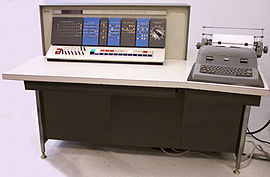
Back IBM 1620 German IBM 1620 Spanish IBM 1620 Finnish IBM 1620 French IBM 1620 Japanese IBM 1620 Korean IBM 1620 Portuguese
This article is written like a personal reflection, personal essay, or argumentative essay that states a Wikipedia editor's personal feelings or presents an original argument about a topic. (March 2022) |
 IBM 1620 Model I, Level H | |
| Manufacturer | IBM |
|---|---|
| Type | Scientific minicomputer |
| Release date | 1959 |
| Units shipped | About 2 thousand |
| CPU | Transistorized, built with SMS cards, variable 12-72 bit words @ 50 kHz (20 us) |
| Memory | 20,000-60,000 words (Core memory) |
| Power | 2 kW |
| Mass | 550 kg (1210 lbs) |
| Predecessor | IBM 650; IBM 610; IBM 608 |
| Successor | IBM 1130 |
| Related | IBM 1710, IBM 1720 |

The IBM 1620 was a model of scientific minicomputer produced by IBM. It was announced on October 21, 1959,[1] and was then marketed as an inexpensive scientific computer.[2] After a total production of about two thousand machines, it was withdrawn on November 19, 1970. Modified versions of the 1620 were used as the CPU of the IBM 1710 and IBM 1720 Industrial Process Control Systems (making it the first digital computer considered reliable enough for real-time process control of factory equipment).[1]
Being variable-word-length decimal, as opposed to fixed-word-length pure binary, made it an especially attractive first computer to learn on – and hundreds of thousands of students had their first experiences with a computer on the IBM 1620.
Core memory cycle times were 20 microseconds for the (earlier) Model I, 10 microseconds for the Model II (about a thousand times slower than typical computer main memory in 2006). The Model II was introduced in 1962.[3]
- ^ a b "1620 Data Processing System". 23 January 2003. Archived from the original on January 14, 2005.
- ^ "Some Key Dates in IBM's Operations in Europe, the Middle East and Africa (EMEA)" (PDF). Archived from the original (PDF) on 2022-10-10.
- ^ "The IBM 1620: Just The Right Machine for Chula's Statistics Department". Archived from the original on 2017-12-22. Retrieved 2017-12-20.